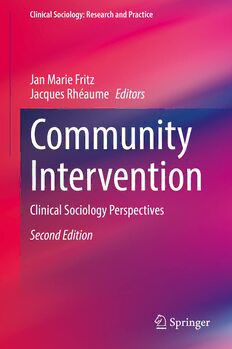
Community Intervention: Clinical Sociology Perspectives (Clinical Sociology: Research and Practice) PDF
Preview Community Intervention: Clinical Sociology Perspectives (Clinical Sociology: Research and Practice)
Clinical Sociology: Research and Practice Jan Marie Fritz Jacques Rhéaume Editors Community Intervention Clinical Sociology Perspectives Second Edition Clinical Sociology: Research and Practice SeriesEditor JanMarieFritz,UniversityofCincinnati,Cincinnati,OH,USA UniversityofJohannesburg,Johannesburg,SouthAfrica Theseriesexploreskeyresearchandpracticeinthisrapidlyexpandingfield.Topics include ethical and legal aspects of intervention; the nature of client relationships; methodsofinterventionandevaluation;andtheroleofclinicalsociologyinspecific settings. This open-ended series appeals to practitioners; policymakers; as well as students and professors in sociology, social work, community psychology, public health,healtheducation,socialpolicyandcounseling. (cid:129) Jan Marie Fritz Jacques Rhéaume Editors Community Intervention Clinical Sociology Perspectives Second Edition Editors JanMarieFritz JacquesRhéaume UniversityofCincinnati DepartmentofSocialandPublic Cincinnati,OH,USA Communication UniversityofQuebecatMontreal UniversityofJohannesburg Montreal,Canada Johannesburg,SouthAfrica ISSN1566-7847 ClinicalSociology:ResearchandPractice ISBN978-3-030-93694-5 ISBN978-3-030-93695-2 (eBook) https://doi.org/10.1007/978-3-030-93695-2 ©TheEditor(s)(ifapplicable)andTheAuthor(s),underexclusivelicensetoSpringerNatureSwitzerland AG2014,2022 Thisworkissubjecttocopyright.AllrightsaresolelyandexclusivelylicensedbythePublisher,whether thewholeorpartofthematerialisconcerned,specificallytherightsoftranslation,reprinting,reuseof illustrations, recitation, broadcasting, reproduction on microfilms or in any other physical way, and transmission or information storage and retrieval, electronic adaptation, computer software, or by similarordissimilarmethodologynowknownorhereafterdeveloped. Theuseofgeneraldescriptivenames,registerednames,trademarks,servicemarks,etc.inthispublication doesnotimply,evenintheabsenceofaspecificstatement,thatsuchnamesareexemptfromtherelevant protectivelawsandregulationsandthereforefreeforgeneraluse. The publisher, the authors and the editors are safe to assume that the advice and information in this bookarebelievedtobetrueandaccurateatthedateofpublication.Neitherthepublishernortheauthorsor theeditorsgiveawarranty,expressedorimplied,withrespecttothematerialcontainedhereinorforany errorsoromissionsthatmayhavebeenmade.Thepublisherremainsneutralwithregardtojurisdictional claimsinpublishedmapsandinstitutionalaffiliations. ThisSpringerimprintispublishedbytheregisteredcompanySpringerNatureSwitzerlandAG Theregisteredcompanyaddressis:Gewerbestrasse11,6330Cham,Switzerland Foreword WearepleasedtointroducethesecondeditionofCommunityIntervention:Clinical SociologyPerspectives,abookthatfocusesontheworkofscholar-practitionerswho foster initiatives to make communities that are safe, livable, green, inclusive, and just. We particularly appreciate how the authors, coming from six different coun- tries,allunderlinetheimportanceofinvolvingthepublicindecisionmaking. We have had a great deal of experience working on projects to improve the community in Cincinnati, Ohio (USA). Susan has been President of the Woman’s City Club, a civic and social justice organization, and is President of the FBI Cincinnati Citizens Academy, providing community outreach and education on safecommunities.SheisalsothecurrentVicePresidentoftheCincinnatusAssoci- ation, a civic and good government organization, and is going through Leadership Ohio, hoping to share in Cincinnati what others around the state of Ohio have accomplished to make communities more livable and inclusive. Meghan is the Executive Director of the Women’s Fund of the Greater Cincinnati Foundation. TheWomen’sFundseekstoimprovethestatusofwomenandgirlsinourregion.Its mission is to lead the community in ensuring the economic self-sufficiency of womenandigniteashareddesiretoimproveit. In2017,theMayorofCincinnatiestablishedaGenderEqualityTaskForce,and wewereelectedtobeCo-Chairs.We,andacoalitionoforganizationsandindivid- uals,hadbeenworkingsince2013togettheCityCounciltopassaResolutionand then two Ordinances using theprinciplesof theUnited Nations’ CEDAW conven- tion (the Convention on the Elimination of All Forms of Discrimination against Women). OurTaskForceof14membersandateamofUniversityofCincinnatiresearchers (whocompletedagenderanalysisofallCityemployees)havemaderecommenda- tions to the Mayor and City Council and have seen several of them already being implemented. It took two long years of education and advocacy for the Cincinnati City Council to pass a Resolution and another two to pass the Ordinances. We are beginningtoseetheirimplementation. v vi Foreword Through our work for the City, we brought people together through data, both quantitative and qualitative, that illustrate both the strengths of the City’s current workandopportunitiesforprogress.Changingthestatusquoisnotforthefaintof heart;itrequirescollaboration,grit,patience,and,aboveall,acompellingvisionfor how everyone can thrive when equity issues are addressed. Involving champions fromvariousCitydepartmentsthroughouttheprocesswascrucialandnowthatwe are beginning to implement more of the recommendations, working with Council Members from across thepolitical spectrum remains apowerful path forward. The messagemustbeclearwithabiastowardaction.Eachstepforward,nomatterhow small,mattersinthemovement.Intheend,ourworkhasillustratedthatcommunity memberswithasharedinterestcaninfluencepolicymakerstoaccomplishimportant changesintheircommunities. Inreadingthechaptersinthisbook,youwillseethatpolicymakingisnotonlya top-downprocess.Allofusneedtolistentoeachotherandworktogethertomakea great number of significant changes in our communities. We need, for instance, to end homelessness; achieve full economic participation; provide affordable renew- able energy; repair/renew our infrastructure; stop the climate crisis; achieve full inclusion;andendviolence.Wewelcomethekindofworkdescribedinthisvolume; it is wonderful to read about research and action projects that move us to a better future. SusanB.Noonan President,SBNConsultingand Co-ChairoftheCincinnatiMayor’s GenderEqualityTaskForce, Cincinnati,Ohio,USA MeghanCummings ExecutiveDirectoroftheWomen’s FundoftheGreaterCincinnati FoundationandCo-Chairof,The CincinnatiMayor’sGenderEqualityTaskForce, Cincinnati,Ohio,USA Community ThomasNast(1840–1902)is“oftenspokenofasthefirstgreatAmericancartoonist” (Murrell and Chipman 1936, p. 472). US President Ulysses S. Grant declared that Nast, as a political cartoonist, “did as much as any one man to preserve the Union andbringthe(U.S.Civil)Wartoanend”(Paine1904,p.106;Reaves1987,p.61). Nast is known for his wood carvings that depicted political dilemmas such as the corruptionofelectedofficialsinNewYorkCity,andhepopularizedthedonkeyand theelephantassymbolsofthetwomainpoliticalpartiesintheUSA.Nastgaveus ourmoderndrawingofSantaClaus. Nast also captured other scenes. “Uncle Sam’s Thanksgiving Dinner” was published by Harper’s Weekly just before the Thanksgiving holiday in November vii viii Community 1869,fouryearsaftertheendoftheUSCivilWar.Inthepicture,aNativeAmerican andthosewhohavecometotheUSAfromallovertheworldareinconversationat the holiday table. The table’s centerpiece is about self-governance and universal suffrage (the right to vote in political elections). The picture on the wall with the “Welcome” sign is a picture of Castle Garden, the first US official immigration center (1855–1890). Nast’s captions at the bottom of the picture read “Free and Equal”and“ComeOneComeAll.”Nast’spictureofthoseatthetable,peopleofall ages and backgrounds, is a picture of rights-based inclusion—a very special Community. References Murrell, W., & Chipman, N. P. (1936). Nast, gladiator of the political pencil. The AmericanScholar,5(1),472–485. Paine, A. B. (1904). Th. Nast: His Period and His Pictures. New York: Harper & Brothers. Reaves,W.W.(1987).ThomasNastandthepresident.TheAmericanArtJournal, 19(1),60–71. Contents 1 IntroductiontotheVolume. . . . . . . . . . . . . . . . . . . . . . . . . . . . . . . 1 JanMarieFritzandJacquesRhéaume PartI TheBasics 2 EssentialsofCommunityIntervention. . . . . . . . . . . . . . . . . . . . . . . 17 JanMarieFritz 3 ResearchfortheCommunity. . . .. . . . . .. . . . . .. . . . . .. . . . . . .. 35 JacquesRhéaume 4 TheResearcher’sMark:BeginwiththeEndinMind. . . . . . . . . . . 49 JeniferCartlandandHollyS.Ruch-Ross PartII SelectedApplications 5 CommunityDevelopmentandEmpowerment: AClinicalSociologyPerspective. . . . . . . . . . . . . . . . . . . . . . . . . . . 65 JacquesRhéaume 6 TheHealthyCities/CommunitiesMovement:FromCholera toCOVID-19. . . . . . . . . . . . . . . . . . . . . . . . . . . . . . . . . . . . . . . . . . 83 HarryPerlstadt 7 ClinicalSociologyandInterculturalPraxisforWorkingwith MigrantsintheCommunity:ATaleofFourProjects. . . . . . . . . . . 105 CatherineMontgomery,SpyridoulaXenocostas,andVaniaJimenez 8 CoeducationinthePopular/NeighbourhoodDistricts ofMarseille. . . . . . . . . . . . . . . . . . . . . . . . . . . . . . . . . . . . . . . . . . . 125 PierreRoche 9 EconomicInterventionsinCommunities. . . . . . . . . . . . . . . . . . . . . 147 Jean-MarcFontanandLucieDumais ix
